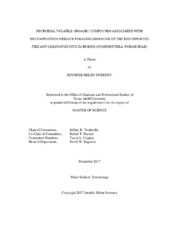| dc.description.abstract | Examining the chemicals involved in interkingdom interactions (e.g., microbe-insect) is useful for understanding the mechanisms governing insect behavior. Recent studies have shown that blow flies (Diptera: Calliphoridae) involved in carrion decomposition are attracted to concentrations of volatile chemical signals emitted by swarming bacterial strains such as Proteus mirabilis (Enterobacteriales: Enterobacteriaceae). This research presents field and laboratory responses of the red imported fire ant Solenopsis invicta Buren (Hymenoptera: Formicidae) (RIFA) to baits with VOCs associated with P. mirabilis to determine dose dependent responses that may be useful for understanding interkingdom interactions and potential applications in forensic entomology and urban pest control.
Field trials took place in two environments in College Station, TX, USA: an agricultural enclosure (rural) and a manicured lawn (urban). Responses to baits treated with one of four compounds diluted to one of two different concentrations were site specific. In the urban environment, indole (IND) at 5.0 μg concentration displayed the highest RIFA attraction to baits at 15% overall; 34% more than the control. Dimethyl disulfide (DMDS) at 0.005 μg concentration displayed the least attraction at 6%; 45% less than the control. In the rural environment, phenylacetic acid (PAA) at 0.1 μg concentration and dimethyl disulfide at 0.25 μg concentration displayed the highest attraction of RIFA response to baits with 17.7% and 17.3% overall attraction; 148% and 142% more than the control bait, respectively. Isobutylamine (IBA) at 0.01 μg concentration displayed the least attraction with 3.5% overall attraction to bait; 50% less attractive than the control.
Laboratory choice assays were conducted to validate results from fieldwork. Following three trials, RIFA attraction to a compound concentration compared to controls of either plain bait or bait with acetone were variable for RIFA attracted to a bait and amount of bait removed. However, IND 0.05 μg and DMDS at both high and low concentrations were the most attractive of the compounds compared to controls.
Like other insects, RIFA respond differently to compounds depending on concentration and environment. Microbial communities may have a significant impact on motivating generalist species to select one resource over another, leading to better pest management strategies. | en |


